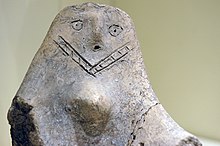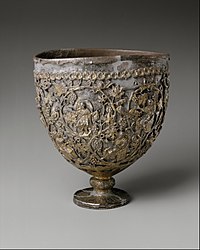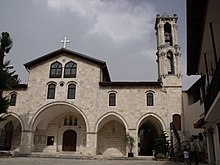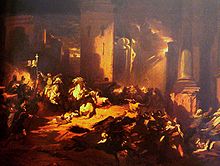Antakya
Antakya (Turkish pronunciation: [ɑnˈtɑkjɑ]),[a] modern form of Antioch,[b] is a municipality and the capital district of Hatay Province, Turkey.
The city is located in a well-watered and fertile valley on the Orontes River, about 20 kilometres (12 mi) from the Levantine Sea.
Today's city stands partly on the site of the ancient Antiochia (also known as "Antioch on the Orontes"), which was founded in the fourth century BC by the Seleucid Empire.
Antioch later became one of the Roman Empire's largest cities and was made the capital of the provinces of Syria and Coele-Syria.
[11] Humans have occupied the area of Antioch since the Chalcolithic (6th millennium BCE), as revealed by archaeological excavations of Alalakh, among others.
[12] The Macedonian King Alexander the Great, after defeating the Achaemenid Empire in the Battle of Issus in 333 BC, followed the Orontes south into Syria and occupied the area.
In 637, during the reign of the Byzantine emperor Heraclius, Antioch was conquered by the Rashidun Caliphate during the Battle of the Iron Bridge.
Since the Umayyad Caliphate was unable to penetrate the Anatolian plateau, Antioch found itself on the frontline of the conflicts between two hostile empires during the next 350 years, so that the city went into a precipitous decline.
It soon became the seat of a dux, who commanded the forces of the local themes and was the most important officer on the Empire's eastern border,[citation needed] held by such men as Nikephoros Ouranos.
[16] Following the defeat of Seljuk forces arriving with the aim to break the siege only four days after its capture by the crusaders, Bohemond I became its overlord.
[17] In addition to suffering the ravages of war, the city lost its commercial importance because trade routes to East Asia moved north following the 13th century Mongol conquests.
Supporters hoped the city might develop thanks to the Euphrates Valley Railway, which was supposed to link it to the port of Sueida (now Samandağı), but this plan never came to fruition.
Antioch was part of the Sanjak of Alexandretta during the Mandate for Syria and the Lebanon, until it was made the Hatay State in 1938, after Turkish pressure.
[20][21] A British traveller visiting Antakya in 1798 reported that generally, Turkish was spoken, while, by contrast, the prevalent language in Aleppo at the time was Arabic.
The draining of Lake Amik and development of land have caused the region's economy to grow in wealth and productivity.
This district is centred on a large park opposite the governor's building and the central avenue Kurtuluş Caddesı.
Rather than formal nightlife, in the summer heat, people will stay outside until late at the night to walk with their families and friends, and munch on snacks.
It did not attract the mass immigration of people from eastern Anatolia in the 1980s and 1990s that radically swelled the populations of Mediterranean cities such as Adana and Mersin.
While almost all the inhabitants are Sunni Muslim, a substantial proportion adhere to the Alevi and Alawite traditions of Islam, in "Harbiye" there is a place to honour the saint Hızır.
Several small Christian communities are active in the city, with the largest church being St. Peter and St. Paul on Hürriyet Avenue.
During a visit to the city in September 2023, The New York Times reported that heavily damaged buildings were still being demolished and no large-scale reconstruction works were observed.
[31] Antakya is located on the banks of the Orontes River (Turkish: Asi Nehri), approximately 22 km (14 mi) inland from the Mediterranean coast.
The Orontes is joined in Antakya by the Hacı Kürüş stream to the north-east of the city near the church of St Peter, and the Hamşen which runs down from Habib-i Neccar to the south-west, under Memekli Bridge near the army barracks.
The city experiences hot, dry summers, and mild, wet winters; though its higher altitude allows for lower temperatures than the coast.
[40] Besides the campus in Serinyol, MKU has its faculties spread out in all main districts of the province including Altınözü, Antakya, Belen, Dörtyol, Erzin, Hassa, İskenderun, Kırıkhan, Reyhanlı, Samandağ and Yayladağı.














